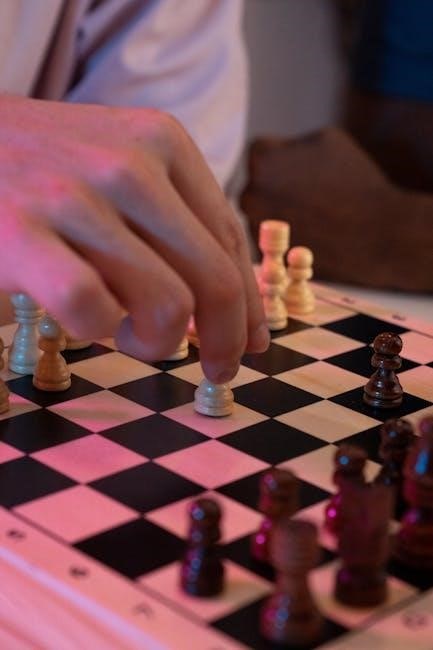Madness is a complex concept, often seen as a breakdown but also a breakthrough. It challenges societal norms and fuels creativity, as explored in How to Go Mad without Losing Your Mind, which examines its role in black radical creativity and mental health.
1.1 Defining Madness in Modern Context
In the modern context, madness is often perceived as a state of mental instability or deviation from societal norms. It can manifest as irrational behavior, emotional turmoil, or a disconnection from reality. However, as explored in How to Go Mad without Losing Your Mind, madness can also be a form of radical creativity and resistance. The book suggests that madness is not merely a mental health issue but a complex interplay of cultural, psychological, and societal factors. It challenges the traditional binary of sanity and insanity, proposing that madness can be a catalyst for transformation and innovation. By examining madness through the lens of black radical creativity, the work redefines it as a powerful tool for navigating systemic oppression and fostering change. This perspective shifts the narrative, framing madness as both a struggle and a source of resilience.
1.2 Historical Perspectives on Madness
Historically, madness has been viewed through varying lenses, often reflecting societal fears and misunderstandings. In ancient times, it was sometimes associated with divine inspiration or possession, while in other periods, it was stigmatized as a moral failing. The book How to Go Mad without Losing Your Mind traces how madness has been both pathologized and romanticized, particularly in the context of black radical creativity. It explores how, throughout history, madness has been a survival mechanism and a form of resistance against oppressive systems. By examining historical narratives, the work reveals how madness has been transformed from a label of shame into a powerful tool for innovation and social change. This historical perspective underscores the idea that madness is not static but evolves in response to cultural and political landscapes, offering a rich tapestry of meanings and interpretations.


1.3 The Intersection of Madness and Creativity
The relationship between madness and creativity is profound, often blurring the lines between chaos and innovation. How to Go Mad without Losing Your Mind delves into how madness has historically served as a catalyst for artistic and intellectual breakthroughs, particularly within black expressive culture. By embracing madness as a form of radical creativity, individuals have transcended conventional boundaries, producing works that challenge societal norms and inspire transformative thinking. This intersection highlights the potential for madness to become a source of empowerment, fostering unique perspectives that drive cultural and social change. The book exemplifies this through various case studies, showcasing how figures in literature, music, and performance have harnessed madness to create groundbreaking works. Ultimately, it suggests that madness, when embraced, can be a powerful tool for innovation and self-expression, offering a pathway to both personal and collective liberation. This dynamic interplay underscores the transformative power of madness in creative endeavors.

The Role of Identity and Culture in Madness
Identity and culture shape perceptions of madness, influencing mental health and societal responses. How to Go Mad without Losing Your Mind explores this interplay, highlighting race and creativity.
2.1 Race, Identity, and Mental Health
Race and identity significantly influence mental health experiences, as explored in How to Go Mad without Losing Your Mind. The book delves into how systemic oppression and societal pressures disproportionately affect Black individuals, leading to unique challenges in maintaining mental well-being. By examining the intersection of race and madness, Bruce highlights how Black identity is often pathologized, contributing to mental health struggles. The text emphasizes the importance of understanding these dynamics to foster resilience and promote healing within Black communities. It also explores how radical creativity can serve as both a coping mechanism and a form of resistance against oppressive structures.
2.2 Societal Pressures and Their Impact on Sanity
Societal pressures play a profound role in shaping mental health, often pushing individuals to the edge of sanity. In How to Go Mad without Losing Your Mind, La Marr Jurelle Bruce explores how systemic oppression and societal expectations exacerbate mental strain, particularly within Black communities. The book highlights the toll of navigating a world that often devalues Black identity, leading to internalized oppression and emotional exhaustion; These pressures can manifest as anxiety, depression, or even a sense of disintegration, where the mind struggles to cope with relentless demands. Bruce argues that embracing radical creativity can serve as a countermeasure, allowing individuals to channel societal pressures into transformative expressions. By examining these dynamics, the text underscores the importance of resilience and the need to redefine sanity in the face of a chaotic and often unjust world.
2.3 The Black Experience and Radical Creativity

The Black experience is deeply intertwined with radical creativity, serving as both a survival mechanism and a form of resistance. In How to Go Mad without Losing Your Mind, La Marr Jurelle Bruce explores how Black individuals have historically harnessed madness as a creative force. This concept challenges traditional notions of sanity by embracing the chaotic and unpredictable. Through music, literature, and performance, Black artists have transformed their struggles into powerful expressions of resilience. Bruce argues that this radical creativity not only provides an outlet for emotional pain but also subverts societal expectations. By reclaiming madness as a source of strength, the Black community continues to innovate and thrive despite systemic oppression. This intersection of madness and creativity highlights the transformative potential of embracing the unconventional and the unknown.

Understanding Madness in Black Literature and Art
La Marr Jurelle Bruce examines madness in Black literature, music, and performance, revealing how it serves as a narrative device for resistance and resilience. This challenges traditional views of sanity and creativity, showcasing the transformative power of embracing chaos.
3.1 Madness as a Theme in African American Literature
In African American literature, madness often emerges as a narrative device to explore themes of oppression, identity, and resilience. La Marr Jurelle Bruce’s work highlights how madness is portrayed not as mere dysfunction but as a form of resistance and empowerment. Through characters who embody madness, authors challenge societal norms and reveal the psychological toll of systemic racism. This theme is evident in works that depict madness as both a consequence of trauma and a source of radical creativity. By examining these narratives, Bruce illustrates how madness becomes a lens to understand the Black experience, blending pain and defiance. This perspective redefines madness, positioning it as a complex, multifaceted phenomenon deeply intertwined with Black cultural expression and survival.
3.2 The Role of Music and Performance in Expressing Madness
Music and performance serve as powerful vehicles for expressing madness, particularly within Black cultural contexts. La Marr Jurelle Bruce’s work emphasizes how these art forms channel the chaos and creativity associated with madness. Through improvisation and raw emotional expression, artists like jazz musicians and blues singers embody madness as a form of resistance and storytelling. Performance becomes a space where the boundaries between sanity and insanity blur, allowing for the exploration of societal pressures and racial identity. This cathartic expression not only reflects personal struggles but also resonates collectively, offering a communal release from oppressive realities. By embracing madness in music and performance, Black artists transform it into a source of innovation and healing, illustrating its dual role as both a burden and a liberating force. This duality underscores the resilience and creativity inherent in Black cultural expression.
3.3 Case Studies of Artists Who Embraced Madness
La Marr Jurelle Bruce’s work highlights artists who transformed madness into creative expression. Figures like Nina Simone and Sun Ra exemplify how madness fueled their artistry. Simone’s music often reflected her emotional turmoil, while Sun Ra’s theatrical performances blurred reality and fantasy. These artists embraced madness as a source of innovation, challenging societal norms. Their work demonstrates how madness, rather than being a limitation, became a catalyst for groundbreaking creativity. By channeling their experiences into art, they redefined madness as a form of resistance and liberation. These case studies illustrate the transformative power of madness in Black cultural expression, showcasing its role in shaping radical creativity and leaving a lasting legacy in music, performance, and art.

Psychological and Emotional Aspects of Madness
Madness profoundly impacts mental health, often manifesting as emotional turmoil. Resilience strategies can transform this chaos into constructive energy, aiding individuals in navigating challenges and finding balance.
4.1 The Psychology of Madness and Its Effects
Madness, as explored in How to Go Mad without Losing Your Mind, represents a psychological state where individuals experience intense emotional and cognitive disruptions. These disruptions can manifest as erratic behavior, heightened creativity, or even profound introspection. The psychological effects of madness vary widely, ranging from debilitating mental health struggles to transformative self-discovery. Bruce’s work highlights how madness can serve as both a challenge and a catalyst for growth, particularly within the context of racial identity and societal pressures. By examining the interplay between mental health and creativity, the text underscores the potential for madness to become a source of radical innovation and resilience, rather than solely a sign of dysfunction. This perspective challenges traditional views of madness, offering a nuanced understanding of its psychological complexities and emotional depths.
4.2 Emotional Resilience and Coping Mechanisms
Emotional resilience and coping mechanisms are crucial for navigating the complexities of madness. La Marr Jurelle Bruce’s work emphasizes the importance of developing these strategies to manage the pressures of societal expectations and racial identity. By fostering emotional resilience, individuals can transform madness into a source of strength rather than weakness. Creative expression, such as music and art, serves as a powerful coping mechanism, allowing individuals to process their experiences and maintain mental well-being. Additionally, community support and cultural practices play a significant role in providing emotional stability. Bruce’s exploration highlights how these mechanisms enable individuals to embrace madness as a form of radical creativity, fostering personal growth and resilience in the face of adversity. This approach not only challenges traditional views of madness but also offers practical ways to thrive in chaotic environments.
4.3 The Fine Line Between Madness and Genius
The line between madness and genius is often blurred, as explored in How to Go Mad without Losing Your Mind. Madness can fuel creativity, pushing individuals to think beyond conventional boundaries. Bruce’s work highlights how societal pressures and racial identity shape this dynamic, where madness is both a struggle and a source of innovation. Genius often emerges from embracing chaos and the unconventional, suggesting that madness can be a catalyst for groundbreaking ideas. This duality challenges traditional perceptions, showing that what may seem like madness can actually be a form of radical creativity. The interplay between these two states underscores the complexity of the human mind and its capacity to transform adversity into brilliance. By exploring this fine line, Bruce offers a new perspective on mental health and creativity, emphasizing the potential for genius within madness.

Societal Pressures and Expectations
Societal pressures and expectations can drive individuals to the brink of madness, yet they also inspire creative resistance and resilience, as explored in Bruce’s work on black radical creativity.
5.1 The Impact of Systemic Oppression on Mental Health
Systemic oppression profoundly affects mental health, creating environments where marginalization and trauma can lead to madness. Bruce’s work highlights how these pressures, particularly on Black communities, foster both despair and radical creativity as survival mechanisms. By examining the interplay between societal expectations and individual resilience, the text reveals how systemic oppression can both break and inspire the mind, urging a reevaluation of madness as a response to an oppressive world rather than merely a personal failing.
5.2 Maintaining Sanity in a Chaotic World
Maintaining sanity in a chaotic world requires embracing the duality of madness and clarity. Bruce suggests that navigating madness involves not resisting it but understanding it as a transformative force. By fostering resilience and creativity, individuals can channel chaos into productive expression, finding balance amid turmoil. This approach emphasizes the importance of radical creativity as a means of resistance and survival, allowing individuals to maintain their identity and purpose even in the face of systemic challenges.
5.3 Finding Freedom in Madness
Finding freedom in madness involves reclaiming it as a source of liberation rather than confinement. Bruce’s work highlights how embracing madness can lead to radical creativity and resistance, offering individuals a way to break free from oppressive structures. Madness, in this context, becomes a form of defiance, allowing individuals to challenge societal norms and expectations. By harnessing the energy of madness, one can find a sense of autonomy and self-expression that traditional forms of sanity might restrict. This perspective shifts madness from a state of dysfunction to a powerful tool for personal and collective transformation, fostering a deeper connection to one’s identity and purpose.

Personal Strategies for Embracing Madness
Embracing madness involves leveraging creativity, self-awareness, and radical expression. Bruce suggests mindfulness practices and creative outlets to transform chaos into clarity, fostering resilience and purpose without losing one’s grounding.
6.1 Mindfulness and Self-Awareness Practices
Mindfulness and self-awareness are crucial for navigating madness without losing grounding. By cultivating present-moment awareness, individuals can embrace chaotic thoughts and emotions while maintaining clarity. Bruce emphasizes practices like meditation and journaling to process internal turbulence, transforming it into a source of creativity and strength. This approach allows individuals to acknowledge their madness as a natural response to systemic oppression and societal pressures, rather than viewing it as a weakness. Through self-reflection and intentional focus, one can harness the energy of madness to fuel personal growth and radical expression. These practices provide a foundation for embracing chaos while staying grounded, enabling individuals to find freedom and purpose in their madness.
6.2 Creative Outlets as a Form of Expression
Creative outlets serve as powerful tools for expressing and navigating madness. Through art, music, writing, or performance, individuals can channel chaotic emotions into meaningful expression. Bruce highlights how black radical creativity transforms madness into art, offering a way to process societal pressures and mental health challenges. These outlets provide an escape from internal turmoil while fostering innovation and self-expression. By embracing creativity, individuals can convert madness into a source of empowerment, illustrating how art and culture are deeply intertwined with the experience of madness. Creative expression becomes a therapeutic and transformative process, allowing individuals to reclaim their narratives and find liberation in their uniqueness.
6.3 Embracing Chaos as a Path to Clarity
Embracing chaos can be a transformative path to clarity, allowing individuals to navigate madness constructively. Bruce suggests that chaos, when harnessed, becomes a catalyst for radical creativity and personal growth. By surrendering to life’s unpredictability, one can uncover hidden patterns and meanings. Madness, in this context, becomes not an endpoint but a gateway to deeper understanding. Black radical creativity often thrives in chaotic spaces, where conventional norms are challenged. This embrace of chaos fosters resilience and innovation, enabling individuals to find clarity amidst turmoil. It is through this lens that madness becomes a tool for liberation, rather than a source of despair. The interplay between chaos and clarity highlights the potential for transformation, offering a pathway to healing and self-discovery.

The Cultural and Philosophical Impact of Madness
Madness has profound cultural and philosophical implications, often challenging societal norms and inspiring creativity. It sparks transformative ideas, reshaping perceptions and fostering innovation across art, literature, and music.
7.1 Madness as a Catalyst for Social Change
Madness has historically served as a powerful catalyst for social change, challenging oppressive systems and inspiring radical transformations. By embracing unconventional thinking, individuals and communities have dismantled societal norms and fought for justice. In the context of Black radical creativity, madness becomes a tool for resistance, fostering innovative solutions to systemic oppression. How to Go Mad without Losing Your Mind highlights how this intersection of mental health and racial identity has fueled movements, from abolition to civil rights, demonstrating that madness can be a source of strength and revolution. Through art, literature, and performance, madness continues to ignite conversations about freedom and equality, proving that radical creativity can lead to profound societal shifts.
7.2 Philosophical Perspectives on Madness and Sanity
Philosophical perspectives on madness and sanity often explore the boundaries between reason and irrationality, challenging traditional notions of mental health. How to Go Mad without Losing Your Mind delves into these themes, suggesting that madness can be a form of resistance to oppressive structures. Philosophers like Michel Foucault have argued that madness is not merely a medical condition but a social construct, shaped by power dynamics and cultural norms. Similarly, the book examines how Black radical creativity embraces madness as a means of reclaiming agency and subverting systemic oppression. By questioning the binary of sanity and madness, these perspectives encourage a deeper understanding of mental health as a fluid and multifaceted experience, rather than a fixed state. This philosophical lens offers a liberatory view of madness, where it becomes a source of insight and transformative power.
7.3 The Legacy of Radical Creativity in Black Culture
Black culture has long embraced radical creativity as a means of survival and resistance, often intertwining it with madness. How to Go Mad without Losing Your Mind highlights how this intersection has produced profound artistic and intellectual contributions. From the works of Langston Hughes to the music of Nina Simone, madness is depicted not as a weakness but as a source of genius. The book explores how Black artists have harnessed madness to confront systemic oppression, creating works that challenge societal norms and inspire change. This legacy underscores the transformative power of embracing chaos and irrationality, turning them into tools for innovation and liberation. By celebrating radical creativity, Black culture continues to redefine madness, positioning it as a catalyst for progress and a testament to resilience.



